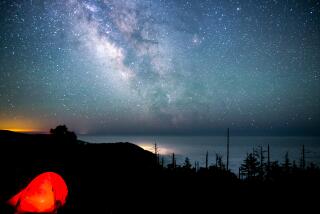People In, Pigs Out on Remote Island
- Share via
VENTURA — The federal government will allow campers to come ashore on Santa Rosa Island for the first time this fall, At the same time, hunters will be killing as many as 4,000 wild pigs.
No campers have been allowed on the island since the National Park Service bought it in 1986. But beginning sometime this fall, 30 campers at a time will be permitted to pitch tents on a grassy plateau on the island’s southeast side and hike in specified areas.
Meantime, hunters will be shooting the feral pigs that have ravaged the island digging up roots, eating acorns and plundering birds’ nests since European settlers abandoned the swine there in 1850, authorities said.
The eradication effort, to be carried out by biologists and Park Service rangers, is the first step in a plan to restore most of the island to its natural state and to turn it into a rustic resort for up to 500 vactioners by the year 2011.
“We’ll make sure hunters and campers won’t mix,” said Mack Shaver, park superintendent. “I don’t think we’ll have so many people that that will be a problem.”
Campers arriving by boat or landing at the island’s airstrip will be welcomed by a ranger and directed to the Water Canyon campground--away from areas where the hunters will be working, Shaver said.
The inauguration of the campground marks the beginning of what Shaver and his colleagues hope will become a “backcountry operation” on the second-largest of the five Channel Islands owned at least partially by the National Park Service.
If proposals are approved as expected by federal officials next year, the island eventually will become a haven for tourists with a taste for rustic vacations. Visitors would be able to ride horses, kayak, tour a research and environmental center and stay in a no-frills bed-and-breakfast inn. Unrestricted camping and backpacking also would be allowed.
Park Service officials want to develop only about 100 acres of the 53,000-acre island and plan to maintain the vintage barns of a ranch on the northeast corner.
None of the island’s dirt roads would be paved under the plan, and workers would commute daily to the island by boat.
“Rugged types” will enjoy the services most, Shaver said. “It’s truly a backcountry island. On Santa Barbara and Anacapa islands, you can hear the ocean all the time and not forget you’re on an island. Here, you can wander back into a canyon and get the feeling you’re on a continent.”
But at least 90% of the island has been ravaged by the pigs, said Kate Faulkner, chief of resources management for the Park Service. They have dug up the roots and eaten the acorns from acres of island oaks, contaminated streams with their feces and preyed on native ground-nesting birds, she said.
The loss of trees and other vegetation has resulted in severe erosion, said Bill Halvorson, a Park Service scientist. On higher clefts of the gray rocks that stud the craggy island, buckwheat and bright yellow coreopsis flowers grow. The flowers should carpet the canyon walls, but they grow only in steep areas where the pigs cannot get at them, Halvorson said.
The Park Service will spend between $200,000 and $800,000 over the next three years to wipe out the pigs under a state mandate to restore native wildlife on the island. In late August, Park Service employees will be flown in from Hawaii to train local rangers, who will be taught to look for the pigs from helicopters and shoot them from the ground.
More to Read
Sign up for The Wild
We’ll help you find the best places to hike, bike and run, as well as the perfect silent spots for meditation and yoga.
You may occasionally receive promotional content from the Los Angeles Times.






